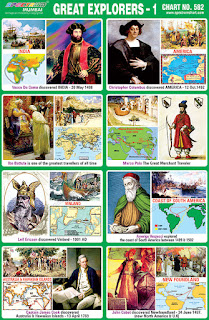 |
| Great Explorers 1 Chart |
Spectrum Chart - 582 : Great Explorers 1
1. Vasco Da Gama
- Vasco da Gama was a Portuguese explorer and the first European to
reach India by sea. His initial voyage to India (1497–1499) was the
first to link Europe and Asia by an ocean route, connecting the
Atlantic and the Indian oceans. On 8 July 1497 Vasco da Gama led a
fleet of four ships with a crew of 170 men from Lisbon & landed
in Calicut on 20 May 1498. His trip to India is widely considered a
milestone in world history, as it marked the beginning of a sea-based
phase of global multiculturalism.
2. Christopher Columbus - Christopher
Columbus was an Italian explorer, navigator, coloniser and citizen of
the Republic of Genoa. In 1492, Columbus was trying to sail to Asia.
Instead he landed in the Bahamas. Columbus wanted to find a shorter
way to get to Asia. He thought he could get to Asia by sailing west
from Europe. He did not know about the countries in the Western
Hemisphere, so he did not realise they would block him from getting
to Asia. Columbus is considered the first European person to have
discovered the Americas.
3. Ibn Batutta - Ibn Battuta was a
Moroccan explorer. He is known for the account of his journeys called
the Rihla. He travelled for nearly 30 years and covered most of the
Islamic world. He also explored West Africa, Southern and Eastern
Europe, South Asia, Central Asia, Southeast Asia and China. This
distance was more than Marco Polo travelled, about 75,000 kilometres.
Ibn Battuta was considered the greatest traveller of the medieval
period.
4. Marco Polo - Marco Polo was an Italian
trader and explorer. He was one of the first Europeans to explore
East Asia. He travelled extensively with his family, journeying from
Europe to Asia from 1271 to 1295. He remained in China for 17 of
those years. Around 1292, he left China, acting as consort along the
way to a Mongol princess who was being sent to Persia. His book Il
Milione describes his travels and experiences and influenced later
adventurers and merchants.
5. Leif Ericson - Leif Ericson was an
Icelandic explorer and the first known European to have discovered
North America(excluding Greenland), before Christopher Columbus.
According to the Sagas of Icelanders, he established a Norse
settlement at Vinland, tentatively identified with the Norse L'Anse
aux Meadows on the northern tip of Newfoundland in modern-day Canada.
The Vikings called it Vinland. This theory is not supported by clear
proof.
6. Amerigo Vespucci - Amerigo Vespucci was
an Italian merchant, explorer and cartographer. He was the first
person to explain that the New World discovered by Christopher
Columbus in 1492 was not the eastern area of Asia, but an unknown
continent (the Americas). America was named after the great man
Amerigo Vespucci.
7. Captain James Cook – Captain James
Cook was a British explorer, navigator, cartographer and captain in
the Royal Navy. He made three voyages to the Pacific Ocean, mapping
many areas and recording several islands and coastlines on European
maps for the first time. He is most notable for the British finding
the east coast of Australia, finding the Hawaiian Islands and the
first mapping of Newfoundland and New Zealand. He also found
Australia. During his lifetime, he sailed twice around the world. He
crossed over the Antarctic Circle and found new islands and
landscapes in North America and the South Pacific.
8. John Cabot - John Cabot was a Genoese
navigator and explorer whose 1497 discovery of parts of North America
under the commission of Henry VII of England is commonly held to have
been the first European exploration of the mainland of North America
since the Norse Vikings' visits to Vinland in the eleventh century.

No comments:
Post a Comment